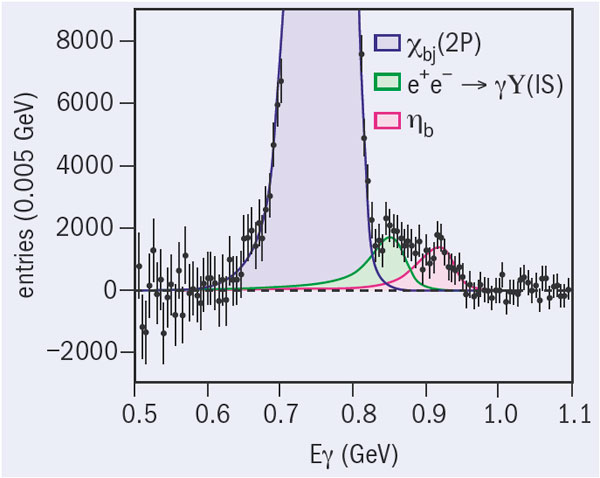The BaBar collaboration, working at SLAC has observed the ground state of the bottomonium family, the ηb meson. Bottomonium particles are bound states of a bottom quark and its antiquark. The first such state, the Υ(1S), was discovered 30 years ago and revealed the existence of the bottom quark. Physicists have been searching for the lowest-energy state of the system ever since.

The ηb was observed in the energy distribution of the photons produced in the radiative decay of the Υ(3S). The two-body decay, Υ(3S) → γηb, produces a monochromatic line with an energy that can be used to determine the ηb mass. The crucial point of the analysis was to understand the photon backgrounds, especially those that form peaks in the spectrum. These include photons emitted in radiative processes such as e+e– → γΥ(1S), which produces photons with energies close to the expected ηb signal, and transitions to intermediate bottomonium states, χbJ(2P).
The team used more than 100 million Υ(3S) events produced from e+e– collisions recorded with the BaBar detector at the PEP-II accelerator. These data were recorded in the final data-collection run of the experiment in 2008. After the analysis selection, approximately 19,000 ηb candidates were identified as forming a peak in the photon-energy spectrum at 921.2 MeV. The significance of this peak is 10 σ.
The corresponding mass of the ηb is 9388.9+3.1-2.1±2.7 MeV/c2, giving a hyperfine mass splitting of 71.4+2.3–3.1±2.7 MeV/c2 between the Υ(1S) and the ηb. This measurement represents the first experimental data on hyperfine mass-splittings in the heaviest meson system, and will allow for more precise tests of the role of spin–spin interactions in QCD.
The BaBar collaboration expects to release further results on bottomonium spectroscopy in the near future.








